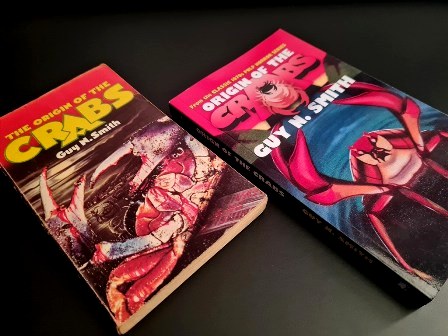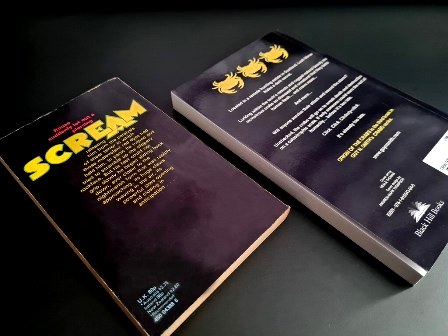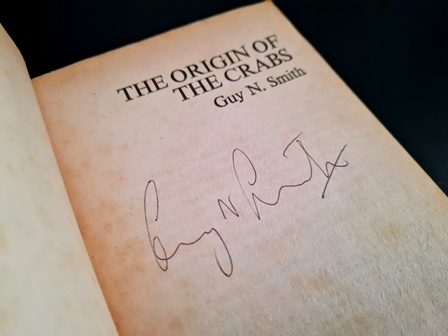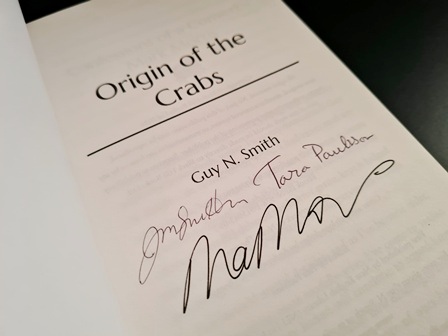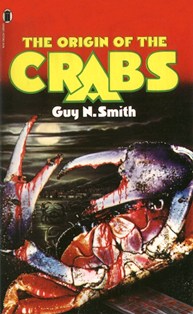
First Edition (1979)
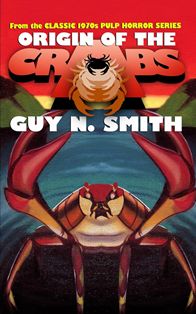
Rerelease (2024)
First published back in June of 1979, ‘The Origin Of The Crabs’ formed the prequel to ‘Night Of The Crabs’ (1976) from within Guy N Smith’s infamous ‘Crabs’ series. ‘Night Of The Crabs’ (1976) and ‘Killer Crabs’ (1978) had already seen publication, allowing this next instalment to slot in at the very start of the series by way of a prequel, setting down the origins of these gigantic crustaceans.
In August 2024, Guy N Smith’s daughter – Tara Paulsson – rereleased the novel under the Black Hill Books publishing company. The rereleased version contained a brand new 7 page introduction by British Author Mark Morris titled ‘Confessions Of A Convert’. The rereleased version dropped ‘The’ from the novel’s title, and the first print run of the rereleased book contained a typo of ‘Origin’ along the spine.
DLS Synopsis:
Deep within the murky Loch Merse of southwest Scotland, a giant crabs takes its first steps on to land. Their first victim is a local poacher who is subsequently ripped apart by these enlarged and vicious crustaceans. Slowly but surely, the crabs are beginning to build up an inherent hatred for mankind and a taste for their blood.
The laird, Bruce McKechnie of Cranlairch, finds himself within a difficult situation, as people begin disappearing around his hunting estate. His lavish livelihood depends on the high fees paid by the guests who stay at his estate to go hunting on his ideal surrounding grounds. After getting wind of the sudden emergence of these giant crabs upon his grounds, McKechnie knows he must keep their presence a secret or he’ll lose his custom pretty damn sharpish.
A worried John Ryland soon turns up to begin investigating the recent disappearance of his brother from the Cranlairch estate. Whilst taking the investigation into his own hands, he pairs up with McKechnie’s mistress Christine Blacklaw, and together they start harassing the laird and searching the grounds for clues.
Meanwhile, McKechnie attempts to cover up the recent disappearances whilst employing a group of hired-hunters to kill off the crabs that are terrorizing his estate. But McKechnie has underestimated his enemy and before long he finds that the crabs are now at war with him and any human they cross...
DLS Review:
The novel starts off with a considerably slower pace than that of the previous two crabs novels, as it sets down the very first attacks on man by these giant crabs. Although the crabs are still considerably larger than that of a standard crab, they still have not yet reached the gigantic proportions seen in the other ‘Crabs’ novels (although a much larger beast is suggested at lurking in the depths of the Loch).
With the storyline gradually building momentum and the bloodshed similarly mounting, Smith delivers another thoroughly outlandish plot to re-introduce the crabs with, whilst pretty much ignoring any notion of detailing the actual origins of these massive crustaceans (although brief hints towards some Russian nuclear testing are thrown in as an afterthought). Nevertheless, the body count gradually rises, delivering graphic depictions of the many gory deaths, whilst McKechnie attempts to rid the Loch of these killer crabs, incorporating increasingly desperate measures.
Although there is a good wedge of action and gruesome violence thrown into the storyline, the tale still feels incredibly restricted with it being a prequel. No matter what atrocities occur in the tale, Smith knows that the presence of the crabs needs to remain hidden from the authorities and the general public in order to maintain the continuity going into ‘Night Of The Crabs’ (1976). Although completely necessary, this time and time again feels like an incredible shame, when Smith sets up numerous situations where the crabs could cause absolute carnage if they were allowed to. However, nothing so glaringly dramatic can happen, which ultimately makes the progression of the tale feel almost totally smothered.
However, Smith does still follow one of his tried and tested formulas with the insertion of Christine Blacklaw to add an injection of good-honest sleazy sex. Furthermore, the general characterisation throughout the novel is ingeniously colourful, with exaggerated personalities adding their own unique impression onto the ensuing storyline. The addition of the rugged protagonist John Ryland, brings a somewhat clichéd (but very Smith-esque) hero to the storyline. However suitable this candidate is to the role of principal protagonist, the character can't help but be judged against that of the already well-established Professor Cliff Davenport, who feels a far superior character in all departments. Sadly, to maintain the continuity, Davenport is left out of the tale.
The novel’s grande finale is surprisingly spectacular, with plenty of nail-biting crab action thrust into the thick of these final pages as the crabs embark upon a huge onslaught onto McKechnie's estate. From such a plodding pace at the start of the book, the novel manages to keep up a healthy degree of momentum, until this dramatic showdown seals the fate of the prequel whilst leaving the reader with an impression that the novel wasn't in the end all that restricted - if only the rest of the novel could have embraced such degrees of crab-ilicious action.
The novel runs for a total of 157 pages.

DLS Synopsis:
Deep within the murky Loch Merse of southwest Scotland, a giant crabs takes its first steps on to land. Their first victim is a local poacher who is subsequently ripped apart by these enlarged and vicious crustaceans. Slowly but surely, the crabs are beginning to build up an inherent hatred for mankind and a taste for their blood.
The laird, Bruce McKechnie of Cranlairch, finds himself within a difficult situation, as people begin disappearing around his hunting estate. His lavish livelihood depends on the high fees paid by the guests who stay at his estate to go hunting on his ideal surrounding grounds. After getting wind of the sudden emergence of these giant crabs upon his grounds, McKechnie knows he must keep their presence a secret or he’ll lose his custom pretty damn sharpish.
A worried John Ryland soon turns up to begin investigating the recent disappearance of his brother from the Cranlairch estate. Whilst taking the investigation into his own hands, he pairs up with McKechnie’s mistress Christine Blacklaw, and together they start harassing the laird and searching the grounds for clues.
Meanwhile, McKechnie attempts to cover up the recent disappearances whilst employing a group of hired-hunters to kill off the crabs that are terrorizing his estate. But McKechnie has underestimated his enemy and before long he finds that the crabs are now at war with him and any human they cross...
DLS Review:
The novel starts off with a considerably slower pace than that of the previous two crabs novels, as it sets down the very first attacks on man by these giant crabs. Although the crabs are still considerably larger than that of a standard crab, they still have not yet reached the gigantic proportions seen in the other ‘Crabs’ novels (although a much larger beast is suggested at lurking in the depths of the Loch).
With the storyline gradually building momentum and the bloodshed similarly mounting, Smith delivers another thoroughly outlandish plot to re-introduce the crabs with, whilst pretty much ignoring any notion of detailing the actual origins of these massive crustaceans (although brief hints towards some Russian nuclear testing are thrown in as an afterthought). Nevertheless, the body count gradually rises, delivering graphic depictions of the many gory deaths, whilst McKechnie attempts to rid the Loch of these killer crabs, incorporating increasingly desperate measures.
Although there is a good wedge of action and gruesome violence thrown into the storyline, the tale still feels incredibly restricted with it being a prequel. No matter what atrocities occur in the tale, Smith knows that the presence of the crabs needs to remain hidden from the authorities and the general public in order to maintain the continuity going into ‘Night Of The Crabs’ (1976). Although completely necessary, this time and time again feels like an incredible shame, when Smith sets up numerous situations where the crabs could cause absolute carnage if they were allowed to. However, nothing so glaringly dramatic can happen, which ultimately makes the progression of the tale feel almost totally smothered.
However, Smith does still follow one of his tried and tested formulas with the insertion of Christine Blacklaw to add an injection of good-honest sleazy sex. Furthermore, the general characterisation throughout the novel is ingeniously colourful, with exaggerated personalities adding their own unique impression onto the ensuing storyline. The addition of the rugged protagonist John Ryland, brings a somewhat clichéd (but very Smith-esque) hero to the storyline. However suitable this candidate is to the role of principal protagonist, the character can't help but be judged against that of the already well-established Professor Cliff Davenport, who feels a far superior character in all departments. Sadly, to maintain the continuity, Davenport is left out of the tale.
The novel’s grande finale is surprisingly spectacular, with plenty of nail-biting crab action thrust into the thick of these final pages as the crabs embark upon a huge onslaught onto McKechnie's estate. From such a plodding pace at the start of the book, the novel manages to keep up a healthy degree of momentum, until this dramatic showdown seals the fate of the prequel whilst leaving the reader with an impression that the novel wasn't in the end all that restricted - if only the rest of the novel could have embraced such degrees of crab-ilicious action.
The novel runs for a total of 157 pages.

© DLS Reviews
Other ‘Crabs’ instalments:
- ‘Night Of The Crabs’ (1976)
- ‘Killer Crabs’ (1978)
- ‘The Origin Of The Crabs’ (1979)
- ‘Crabs On The Rampage’ (1981)
- ‘Crabs’ Moon’ (1984)
- ‘Crabs: The Human Sacrifice’ (1988)
- ‘Crabs Fury’ (1998) [Graphic Novel]
- ‘Crabs’ Armada’ (1998) [Audiobook CD]
- ‘Crabs: Unleashed - The Collection’ (2009) [Chapbook]
- ‘Crabs: Unleashed’ (2009) [Chapbook]
- ‘Crustacean Vengeance’ (2009) [Chapbook]
- ‘The Decoy’ (2009) [Chapbook]
- ‘Crabs’ Armada’ (2009) [Chapbook]
- ‘Killer Crabs: The Return’ (2012)
- ‘Crabs Omnibus’ (2015)
- ‘The Charnel Caves’ (2019)
